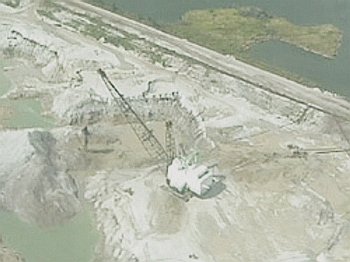In this slightly below average Occasional you'll learn how water is recycled in car washes, what's going on at the water plant in Waurika, Oklahoma, how colloidal particles are removed from water, how many new Colorado and Nile Rivers the world needs, where they get the "fluoride" that they put into drinking water, the percentage of Atlanta's swimming pools that contain human feces, the age of the world's oldest water, and what Khloe Kardasian was doing when she was filmed in Greece. Learn about spin down filters, the Enhanced Performance Fluoride Filter, hydrofluorosilicic acid, arsenic in city water, and, as always, there is much, much more.
The Pure Water Occasional is a weekly email newsletter produced and issued by Pure Water Products of Denton, Texas. We also publish the Pure Water Gazette, which posts new articles about water and water treatment daily and provides "vast piles of information in the Gazette's tangy, irreverent style" (Cleveland Plain Dealer). We also maintain what we believe to be the most informative commercial water treatment site on the worldwide web, PureWaterProducts.com.
If you would like to read this issue on the Pure Water Gazette’s website, go here.
Needed: 100 More Colorado Rivers
by Elizabeth Cutright
A study released by the InterAction Council recommends that the UN Security Council make water scarcity “a top concern.”
“The future political impact of water scarcity may be devastating,” former Canadian Prime Minister Jean Chretien said of the study, which was issued by a consortium of former world leaders, including Nelson Mandela and US President Bill Clinton, and backed by the UN University’s Institute for Water, Environment, and Health (UNWEH) and Canada’s Gordon Foundation.
Pointing to factors as diverse as climate change and geo-political confrontations, the group warned that increasing water scarcity will only exacerbate crises around the globe, including the spread of disease, rising infant mortality rates, and global food production.
“With about 1 billion more mouths to feed worldwide by 2025, global agriculture alone will require another 1,000 cubic km (240 cubic miles) of water per year,” the report states—an increase that is the equivalent of 20 Nile rivers or 100 Colorado Rivers.
Other highlights from the report:
* Currently, 3,800 cubic km (910 cubic miles) of freshwater are extracted from the world’s rivers and streams annually.
* The greatest increase in demand for water will be located in the US, China, and India, in part because of population increases, increased agricultural irrigation, and economic growth.
* By 2030, China’s water needs will exceed its current supplies.
A study shows that by 2025 the world will need the equivalent of 20 more Nile Rivers to feed the increasing population.
* Global warming and GHG emissions are expected to aggravate current climate patterns and impact drought/rainfall totals worldwide, with droughts and floods becoming more common.
But the report offers solutions as well—solutions familiar to any regular reader of Water Efficiency. Dubbing it the “blue economy,” the report suggests that an emphasis on water conservation could mitigate some of the world’s water scarcity issues. By improving infrastructure—including leak detection and demand reduction—the report estimates that up to 40% of domestic water that is currently wasted could be saved.
But these water efficiency measures won’t come cheap, another familiar challenge for the water purveyor. The UNWEH report calculates infrastructure improvement costs in developing nations to be about $11 billion per year. But that outlay does not come without a payback—for every dollar spent, communities could see an economic return from $3–4 dollars, according to the report.
So what do you think? Can clarion calls like this have any impact on government programs and policies? Is it enough to simply raise awareness of the impending water crisis? And what more can be done to funnel the much-needed funds towards infrastructure rehabilitation and improvement at home and abroad?
Source: Water Efficiency
Industrial-grade Fluoridation Chemicals
Cost Society $Billions in Arsenic-induced Cancers
The “fluoride” that’s put in city water supplies, called hydrofluorosilicic acid, or HFSA, is not the same thing as the pharmaceutical-grade fluoride that is used by dentists. Among other contaminants in additive-grade fluoride is arsenic. In fact, ninety percent of the arsenic found in city tap water comes from HFSA.
Editor’s Note: The bulk of this article is taken directly from Fluoridealert.org, but I’ve added a bit from an interesting study of hydrofluorosilicic acid from Waterloowatch.com. Although the origins of the “fluoride” that is used in municipal water treatment are not kept secret, the American public is woefully naive on the issue and most people do not realized that the substance they are trusting to to save their children’s teeth is actually a toxic by-product of the fertilizer industry.–Hardly Waite.
Industrial-grade fluoride chemicals added to US public water supplies contain arsenic that the EPA classifies as a human carcinogen. Switching to low-arsenic pharmaceutical-grade fluoride will save society $1 billion to $14 billion annually, according to research published in Environmental Science & Policy, led by former EPA senior scientists who are experts in chemical risk assessment, reports the Fluoride Action Network (FAN).
Almost all hydrofluorosilicic acid used in North America originates in the State of Florida, where phosphate containing rock is strip-mined. (See picture.)
Hydrofluorosilicic acid is drawn from open air cooling lakes, as is. It is containerized in tankers, and shipped to your municipal drinking water supply. Hydrofluorosilicic acid remains contaminated with trace amounts of lead, arsenic, mercury and radioactive materials. It is delivered unrefined, and in non-pharmaceutical grade, to be used as water fluoridation ‘product.'
Although never studied for safety or efficacy, hydrofluorosilicic acid (HFSA) is added to public water supplies as a purported cavity preventive. The industry-funded group that regulates water additives, NSF International, allows several toxins in HFSA, including arsenic.
The Safe Drinking Water Act requires EPA to determine the level of certain contaminants in drinking water at which no adverse health effects are likely to occur. These health goals, based solely on possible health risks and exposure over a lifetime with an adequate margin of safety, are called maximum contaminant level goals (MCLG). The MCLG for arsenic is zero. The EPA also sets an enforceable maximum contaminant level (MCL), but concedes this level will not prevent cancers.
Senior researchers, Drs. William Hirzy and Robert Carton , write, “Arsenic levels in this HFSA product vary substantially but are typically about 30-35 mg/kg.” These levels would qualify it as toxic hazardous waste if not for a legal loophole because it is sold to fluoridate water. The study found HFSA raised the arsenic level of finished or tap water by anywhere from 0.078 to 0.43 parts per billion (ppb).
Ninety percent of arsenic showing up in tap water comes from fluoridation chemicals, according to a study in the American Water Works Association publication, Opflow, led by Dr. Cheng-nan Weng.
Hirzy and Carton found that industrial-grade HFSA contains from 100 to 500 times more arsenic than pharmaceutical grade sodium fluoride (NaF).
Using EPA’s calculation methods, HFSA would cause from 320 to 1800 arsenic-induced cancers per year. They calculated these cancers would cost society $1 billion to $6 billion per year.*
The researchers conclude: “Our analysis shows that, if local governments that currently add HFSA to their drinking water wish to continue delivering fluoride to their citizens and at the same time reduce the number of lung and bladder cancers among their citizens, they could do so with a significant net benefit to society by switching to USP NaF [pharmaceutical grade Sodium Fluoride] for fluoridation.”
Reference: Hirzy JW, Carton RJ, Bonanni CD, Montanero CM, Michael F, Nagle MF. 2013. Comparison of hydrofluorosilicic acid and pharmaceutical sodium fluoride as fluoridating agents—A cost–benefit analysis. Environmental Science & Policy 29: 81-86 (May).
News Briefs
As summer approaches, the following news clip should cheer you up:
A new report by the federal government makes a disturbing claim saying a lot of public pools in the country are contaminated with human feces.
Many families are hoping to stay cool this summer by jumping into their neighborhood pools, but a new report released by the U.S. Centers for Disease Control and Prevention has some people rethinking their plans.
According to the report, researchers found that 58% of pools in Atlanta were contaminated with E. coli– a bacteria found in human feces.
The oldest water ever found in large amounts has been discovered by Canadian gold miners. The water is believed to be more than 1.5 billion years old and is from an ancient ocean.
A new twist on nanoscavengers with what its proponents call "synthetic antiferromagnetic cores" has been developed by scientists at Stanford University. The Stanford researchers claim to have solved the main problem with nanoscavengers--the difficulty of removing them from water after they've done their job--by developing a synthetic core nonoscavenger that can eliminate 99% plus E. coli and still be removed from the water magnetically.
Worst Water Story of the Week: Khloe Kardashian and Kylie Jenner were photographed doing water cheerleading while vacationing in Greece.
New from the Pure Water Gazette:
How Water Is Recycled in Modern Car Wash Establishments
There are advantages to using professional carwash facilities rather than relying on fundraising events to keep your car clean or even doing it yourself in your driveway. The pros not only reuse water; they keep car wash chemicals out of the drainage system. This article explains how the pros recycle carwash water.
The Spin Down (AKA Spin Out) Separator: A Very Useful Tool in Water Treatment
"Spin down" filters, also called spin out filters or inline separators, provide an inexpensive solution for filtering large particles like sand where high flow rates and minimum upkeep are important.
A New Style Water Treatment Called ADMIN Is Being Tested in Waurika, Oklahoma
Small town water suppliers are often forced to comply with regulatory issues and have little money in the town treasury to deal with them. This story tells how one town in Oklahoma is taking a gamble on fixing its THM problem with an unconventional solution.
One of the most difficult problems in water treatment is how to get rid of colloidal particles that are too tiny to be caught by anything but the tightest of filters. A standard way of doing this–and the method used by most municipal water systems–is to add a chemical (usually aluminum sulfate) to promote coagulation and flocculation to increase the size and weight of the particle, allowing it to precipitate out of solution or be trapped by a filter. The process is described in some detail by the WHO document that is excerpted in this article.
Our Super Undersink Fluoride Filter
by Gene Franks
In December of 2008 we sold the first of a product we call our "Enhanced Performance Fluoride Filter" (wish we could think of a sexier name) and I would say the product has been a big success. Customer satisfaction has been high and sales have been significant. When we introduced it, we called it "the second best way to remove fluoride from drinking water," and we still advise people that reverse osmosis is really the best fluoride product.
The filter's uniqueness is that it addresses the main problem with fluoride filters which is that activated alumina, the fluoride reduction medium used in ours and virtually all fluoride filters, requires much more "residence time" with the water to do its job than other media like carbon need to do theirs. The user, therefore, is required to wait for the water to trickle from the filter or settle for less-than-ideal fluoride reduction with normal-speed delivery. Our unit sends water through the fluoride reduction cartridge at an acceptable 1/4 gallon per minute (a trickle), but delivers it from the faucet at normal drinking water speed of 3/4 to 1 gpm. This isn't accomplished by magic but by clever use of a few standard water treatment parts like a reverse osmosis tank, a flow restrictor, and a check valve.
Thank you for reading, and please stay tuned next Monday for another wisdom-packed Occasional.
Places to Visit on Our Websites
Model 77: “The World’s Greatest $77 Water Filter”
Sprite Shower Filters: You’ll Sing Better!
An Alphabetical Index to Water Treatment Products
Sprite Shower Filters: You’ll Sing Better!
An Alphabetical Index to Water Treatment Products
Write to the Gazette: pwp@purewaterproducts.com
Please Visit
The Pure Water Gazette – now in an easier to navigate format.
![occasionalbanner300[1]](https://ymlp.com/https.php?id=purewatergazette.net/blog/wp-content/uploads/2013/04/occasionalbanner3001.gif)




![uf050_350[1]](https://ymlp.com/https.php?id=purewatergazette.net/blog/wp-content/uploads/2013/05/uf050_3501.jpg)